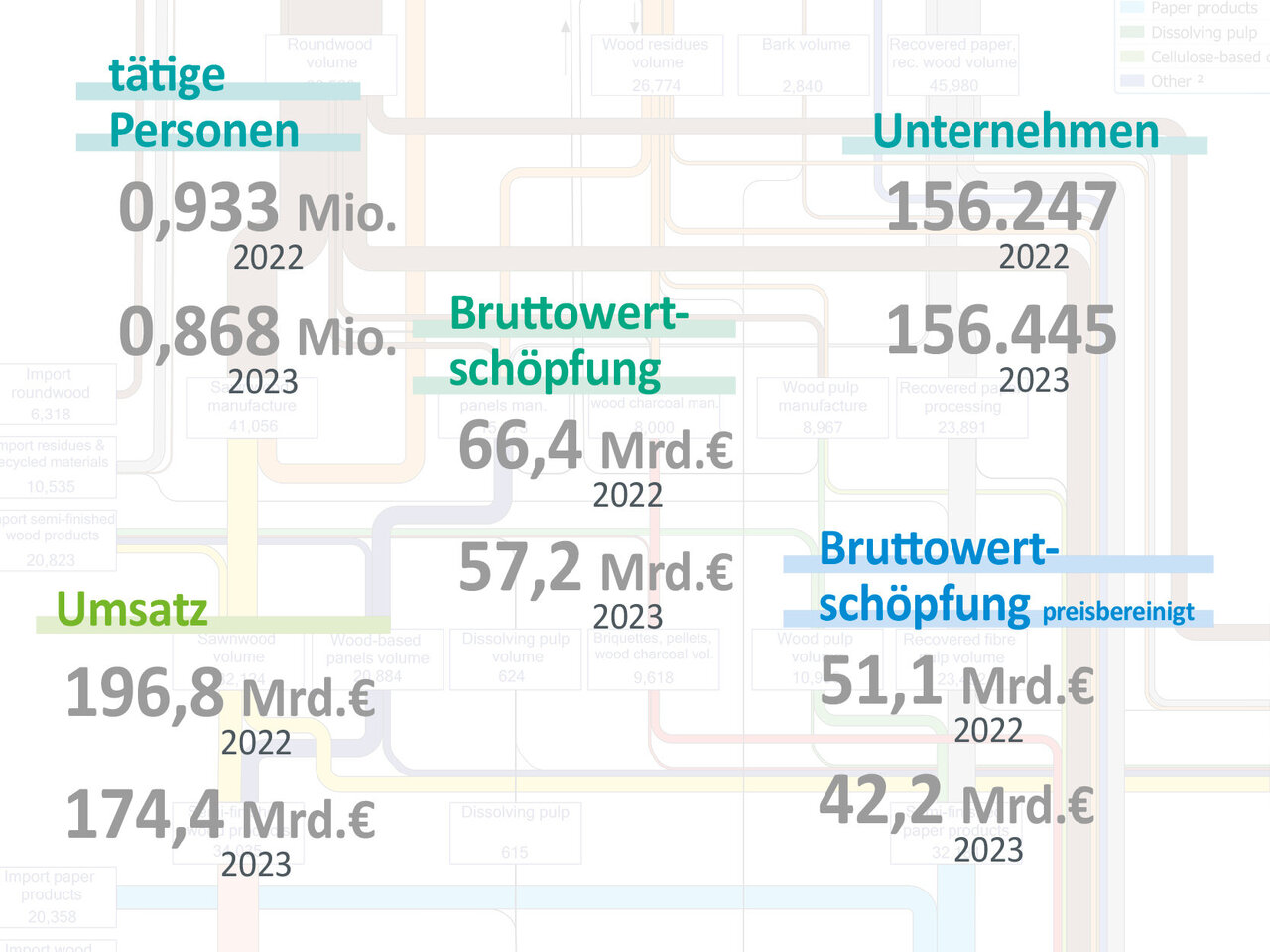Project
Cluster Statistics

Updating structural data of the forestry and timber cluster
Based on official statistics we analyse the forestry and timber cluster. We quantify number of jobs and enterprises, turnover and value added of forestry and wood-based economic activities.
Background and Objective
Viewed separately, German forestry as a producer of roundwood is of negligible economic importance. However, numerous subsequent industries are dependent on the use of roundwood. Thus, all economic activities using or providing roundwood, semi-finished or finished products constitute the forestry and timber cluster. Since the reporting year 2000, cluster analysis is carried out based on a comprehensive methodology. Due to recent changes in official data availability and wood use, the cluster statistics methodology has been updated from the reporting year 2021 on. Forestry and timber cluster data continues to provide relevant information to industries, policy makers and science.
Target Group
science, policy, enterprises and market associations, interested public
Approach
Using official data we compile annual overviews on employment, number of enterprises, and determine value added for the forestry and wood industries. Based on wood material flow data provided in other tasks of Thünen Institute of Forestry and additional official data, we regularly review the relevance of economic activities to the forestry and timber cluster. The cluster analysis includes those economic activities that actually use or produce wood or wood-based semi-finished and finished products. Changes in the use of wood can therefore also change the composition of the cluster.
Our Research Questions
What is the socio-economic significance of roundwood production and its further processing in Germany?
How do the shares of the respective sectors within the forestry and timber cluster change?
How does wood use change?
Preliminary Results
Latest results are regularly published under Facts&Figures.
Links and Downloads
www.thuenen.de/en/institutes/forestry/figures-facts/clusterstatistics-forest-and-timber
www.thuenen.de/en/institutes/forestry/figures-facts/holzeinschlag-und-rohholzverwendung
www.thuenen.de/en/institutes/forestry/figures-facts/european-forests-accounts-efa
www.thuenen.de/en/cross-institutional-projects/evaluation-of-the-charter-for-wood-20
www.thuenen.de/en/cross-institutional-projects/bio-economy-monitoring
www.thuenen.de/en/cross-institutional-projects/translate-to-english-biooekonomie-monitoring-ii
Thünen-Contact

Involved Thünen-Partners
Duration
Permanent task 1.2001
More Information
Project status:
ongoing
List of Publications
- 0
Iost S, Glasenapp S, Jochem D (2025) Clusterstatistik Forst und Holz : Entwicklung seit 2000 und methodische Anpassung im Kontext der Bioökonomie. Braunschweig: Johann Heinrich von Thünen-Institut, 77 p, Thünen Working Paper 273, DOI:10.3220/253-2025-139
- 1
Iost S, Meyer E (2025) Clusterstatistik Forst&Holz Datenbank bis 2020 [Datenpublikation]. 1 -ACCDB Datenbank; 2. Auflage. Göttingen: OpenAgrar, DOI:10.3220/253-2025-46
- 2
Iost S, Meyer E (2025) Clusterstatistik Forst&Holz Datenbank bis 2020 [Datenpublikation]. 1 -ACCDB Datenbank. Göttingen: OpenAgrar, DOI:10.3220/253-2025-1
- 3
Iost S (2025) Clusterstatistik Forst&Holz Tabelle für 2023 [Datenpublikation]. 1 CSV-Datei. Göttingen: OpenAgrar, DOI:10.3220/253-2025-174
- 4
Iost S, Meyer E (2025) Clusterstatistik Forst&Holz Tabellen bis 2020 [Datenpublikation]. 7 CSV-Dateien, 1 TXT-Datei. Göttingen: OpenAgrar, DOI:10.3220/253-2025-41
- 5
Iost S (2025) Clusterstatistik Forst&Holz Tabellen für 2021 und 2022 [Datenpublikation]. 1 XLSX-Datei. Göttingen: OpenAgrar, DOI:10.3220/253-2025-136
- 6
Iost S, Weimar H (2024) Die Clusterstatistik Forst & Holz als wichtige Grundlage des Monitorings der deutschen Bioökonomie. In: Technische Universität Dresden (ed) FowiTa 2023 : Forstwissenschaftliche Tagung vom 11.-13. September 2023 in Dresden ; Wald- und Holzforschung zwischen Klimawandel, Bioökonomie und gesellschaftlichen Umbrüchen [Abstractband]. p 141, DOI:10.25368/2024.36
- 7
Becher G, Weimar H (2020) Branchen des Clusters entwickeln sich meist positiv. Holz Zentralbl 146(6):132-133
- 8
Becher G, Weimar H (2016) Cluster Forst und Holz: leicht rückläufige Entwicklung : aktuelle Berechnung für das Jahr 2013 und den Zeitraum 2000 bis 2013 der Clusterstatistik verdeutlicht die Trends der Branche. Holz Zentralbl 142(1):14-16
- 9
Becher G (2016) Clusterstatistik Forst und Holz : Tabellen für das Bundesgebiet und die Länder 2000 bis 2014. Braunschweig: Johann Heinrich von Thünen-Institut, 85 p, Thünen Working Paper 67, DOI:10.3220/WP1479976770000
- 10
Becher G (2015) Clusterstatistik Forst und Holz : Tabellen für das Bundesgebiet und die Länder 2000 bis 2013. Hamburg: Johann Heinrich von Thünen-Institut, 109 p, Thünen Working Paper 48, DOI:10.3220/WP1443683579000
- 11
Becher G (2014) Clusterstatistik Forst und Holz : Tabellen für das Bundesgebiet und die Länder 2000 bis 2012 . Hamburg: Johann Heinrich von Thünen-Institut, 105 p, Thünen Working Paper 32, DOI:10.3220/WP_32_2014








